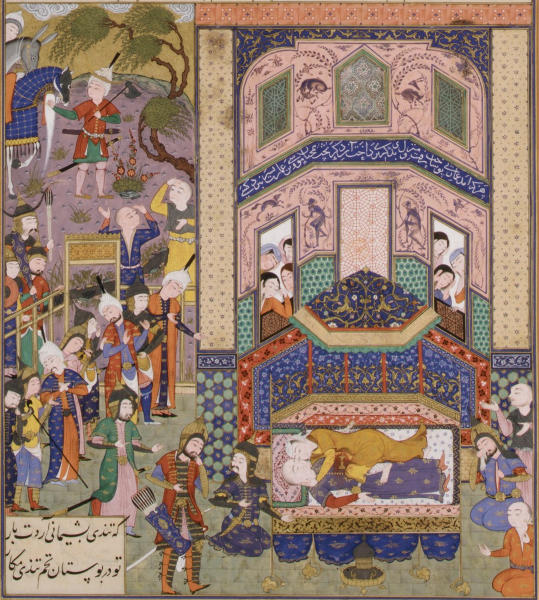The Iranians Mourn the Death of Farud and Jarira: From the Shahnama (Book of Kings) of Shah Tahmasp, ca. 1525-30
Attributed to Mirza Muhammad Qabahat
Iran, Tabriz
Colors, ink, silver, and gold on paper
18 5/8 x 12 1/2 in. (47.3 x 31.8 cm)
Gift of Arthur A. Houghton Jr., 1970 (1970.301.35)
The Shahnama is filled with tragic events and moments of intense drama.
On the page illustrated here, the painters have depicted the mourning of Iranians over the tragic destiny of Farud, the son of Prince Siyavush, and Jarira, his mother.
After witnessing her son's death, Jarira ripped open her belly with a dagger. Then, lying down with her face against Farud's, she let herself die.
The scene is one of the most emotionally charged in the entire manuscript.
The women pull out their hair and cry, the courtiers beat their heads in despair, while the creased expressions on their faces convey intense compassion.
Even though Islamic painting is considered to be idealized, the painters of this Shahnama reveal instead a profound awareness of human emotions,
which are depicted with great sensitivity.
Citation
"Attributed to Mirza Muhammad Qabahat: The Iranians Mourn the Death of Farud and Jarira: From the Shahnama (Book of Kings) of Shah Tahmasp
(1970.301.35)". In
Heilbrunn Timeline of Art History. New York:
The Metropolitan Museum of Art, New York.
"The Iranians Mourn Farud and Jarira", Folio 236r from the Shahnama (Book of Kings) of Shah Tahmasp
Author: Abu'l Qasim Firdausi (935–1020)
Artist: Painting attributed to Mirza Muhammad Qabahat
Artist: Painting attributed to 'Abd al-'Aziz (active first half 16th century)
Object Name: Folio from an illustrated manuscript
Date: ca. 1525–30
Geography: Made in Iran, Tabriz
Medium: Opaque watercolor, ink, silver, and gold on paper
Dimensions: Painting: H. 11 1/4 x W. 7 5/16 in. (H. 28.6 x W. 18.6 cm)
Entire Page: H. 18 5/8 x W. 12 1/2 in. (H. 47.3 x W. 31.8 cm)
Classification: Codices
Credit Line: Gift of Arthur A. Houghton Jr., 1970
Accession Number: 1970.301.35
The Shahnama is filled with tragic events and moments of intense drama. On the page illustrated here, the painters have depicted the mourning of Iranians over the tragic destiny of Farud, the son of Prince Siyavush, and Jarira, his mother. After witnessing her son's death, Jarira ripped open her belly with a dagger. Then, lying down with her face against Farud's, she let herself die.
The scene is one of the most emotionally charged in the entire manuscript. The women pull out their hair and cry, the courtiers beat their heads in despair, while the the creased expressions on their faces convey intense compassion. Even though Islamic painting is considered to be idealized, the painters of this Shahnama reveal instead a profound awareness of human emotions, which are depicted with great sensitivity.
The Metropolitan Museum of Art, New York, 1970.301.35


